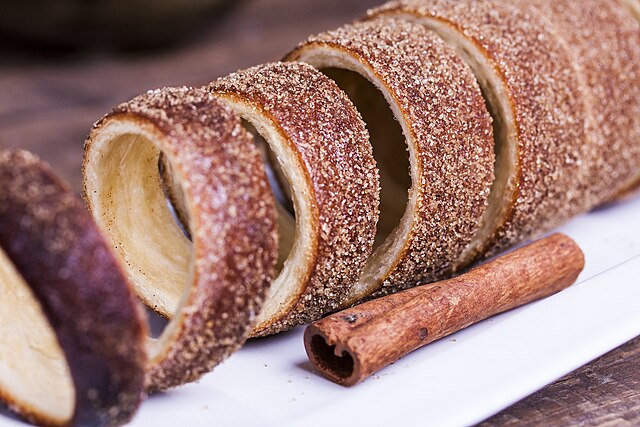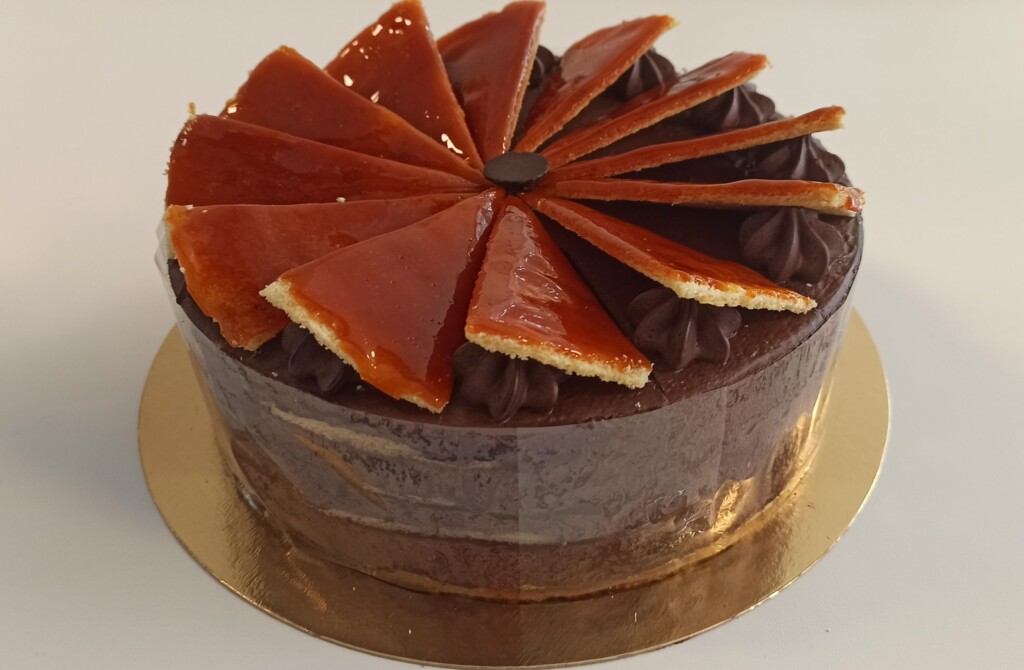4 Most Popular HUNGARIAN SAUSAGES AND SALAMIS
- November 14, 2023
- Food
Budapesti téliszalámi Budapesti téliszalámi is a smoked and dried cylindrical sausage made with pork meat and pork fat coming from castrated male... Read More


For classic comfort food on the go, pick up a Lángos, a deep fried doughy flatbread that’s eaten warm and slathered with sour cream and grated cheese or with garlicky butter (or all of the above). These hearty snacks are served all year round and make for an affordable savory treat. The perfect Lángos should be crisp on the outside and soft and plump in the middle. Sometimes they’re made with potato (krumplis lángos) and are occasionally served with sausage (kolbász) on top.
Where to eat Lángos in Budapest: Retro Bufe has outposts throughout the city, with some locations opening as early 6 a.m. for early risers.

These sweet treats are made from long strips of sugary dough wrapped around cone-shaped spits that are brushed with butter and roasted over charcoal. The sugar caramelizes to form a crispy coating and when the dough is removed from the spit, steam is released from the center like a chimney (the English translation of kürtőskalács is ‘chimney cake’.) Before serving they’re usually dusted with toppings like cinnamon or ground walnuts and are designed to be shared, with each person tearing off a strip of the hot, sweet, crunchy dough. They’re especially popular during the festive season and are sold at Christmas markets throughout the city.
Where to eat kürtőskalács in Budapest: There are tons of stalls that sell these sweet treats all over town. The quality is pretty consistent but be sure to order a kürtőskalács that’s been freshly cooked rather than one that’s been sitting on display for a while. The stall at the corner of Andrássy Avenue and Bajcsy-Zsilinszky Street is popular with locals.

Stuffed cabbage is a popular dish across much of eastern Europe as well as parts of Asia. The Hungarian specialty features cooked cabbage leaves stuffed with ground pork and beef, rice, tomatoes, and sauerkraut. As with many Hungarian dishes, it’s generously flavored with paprika. This comforting dish is usually eaten in winter and is definitely worth sampling when in Hungary as it’s fiddly to assemble at home.
Where to eat töltött káposzta in Budapest: Százéves Restaurant has been serving traditional Hungarian dishes like stuffed cabbage since 1831. It’s the city’s oldest restaurant and often plays host to live gypsy bands.

Hungary’s national dish tends to be served as a stew in most parts of the world but an authentic gulyás is actually a thin broth made from chunks of beef cooked with onions, paprika, tomatoes, and pepper. It’s usually served with fresh white bread and chopped hot paprika on the side. It’s traditionally a peasant dish and was originally cooked by herdsmen in cast iron bogrács cauldrons over open fires. You’ll still find the dish being cooked up in this way in rustic restaurants across Hungary as it’s considered the best way to make this tasty stewy soup.
Where to eat goulash in Budapest: Baltazar Budapest is a hip hidden gem in the city’s Castle District that serves classic Hungarian dishes in a contemporary setting. The goulash here is very highly rated.

This show-stopping sweet treat is served in cafes and bakeries across the country and is a popular celebration cake at weddings and parties. It’s made up of between five and seven delicate sponge layers, each spread with chocolate buttercream and topped with a thick layer of caramelized sugar (for a satisfying crack when tapped with a fork). The sides of the cake are usually coated in ground nuts like hazelnuts, walnuts, or almonds. It was invented by (and named after) top pastry chef Jozsef C. Dobos and was first served to King Franz Joseph I and Queen Elisabeth at the National General Exhibition of Budapest in 1885.
Where to eat Dobos torta in Budapest: In the heart of the Jewish quarter, Fröhlich Cukrászda is a simple kosher bakery that has been baking traditional cakes for over half a century.

Sausages are a big deal in Hungary. They are featured in dishes served at breakfast, lunch, and dinner and pop up in stews, soups, salads, and pastries. Kolbász is the catch-all term for Hungarian sausage and there are many different varieties on offer that are served cooked, boiled, cured or smoked. Don’t leave without sampling csabai kolbász, a spicy sausage flavored with paprika; Gyulai kolbász, a beech wood-smoked sausage from the town of Gyula; and májas hurka, a boiled liver sausage.
Where to eat kolbász in Budapest: For the best selection of sausages, head to Budapest’s Central Market, a vast three-story neo-gothic building filled with stalls selling excellent kolbász, cold cuts, and traditional Hungarian produce.

While it might sound like something you’d have at the end of a meal, Gyümölcsleves is typically served as a chilled starter or a light summer dish. The most popular version of this refreshing delicacy is meggyleves, made from sour cherries, sour cream, and a little sugar. This kind of soup is eaten across Central and Eastern Europe where stoned fruit grows abundantly in the spring and summer.
Where to eat in Gyümölcsleves Budapest: Kispiac Bisztro is a cute little restaurant near the basilica that serves excellent fruit soup all summer long.
Latest Comments